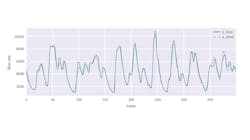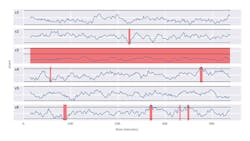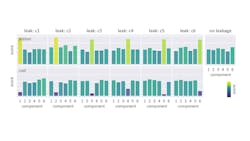Machine Learning Models Predict Compressed Air Anomalies
At a Glance:
- Compressed air makes up as much as 30% of all energy costs in a plant and almost one-third of all generated compressed air is estimated to be wasted.
- Using machine learning and artificial intelligence can identify and predict many system failures before they can occur.
- One key metric is flow rate, which provides a reference for the ideal air flow.
- AI prediction models can help reduce costs and avoid unplanned shutdowns, which means a quick ROI for system costs.
The energy supply in a company is not only essential for successful industrial production, but also represents a significant cost factor in manufacturing. For this reason, manufacturing companies, as well as developers of components for energy supply, are more frequently concerned with optimizing their production and products.
Across discrete and hybrid industries, the production of compressed air is responsible for as much as 30% of overall energy costs and therefore represents one main cost for energy supply within these industrial environments. Moreover, a significant portion of this cost is unnecessary, since nearly a third to a fourth of industrial compressed air consumption is waste caused by leaks. Thus, leaks in compressed air supply have been identified as a significant cost driver in industrial production.
However, the growing complexity of industrial pneumatic systems induces a more complex failure identification by means of the concrete subsegment or component at which the loss of compressed air occurs. So not only early detection but also the most accurate possible location of such leaks can reduce maintenance costs and reduce unplanned downtime, and by this ensure and improve the overall equipment efficiency of the industrial system.
Early detection and identification of leaks will generally reduce the amount of energy consumed, reduce CO2 footprint and maintenance costs and avoid unplanned downtime by improving overall equipment efficiency.
The digital enhancement of industrial productions has led to a state where these environments are equipped with a variety of sensors and data aggregation points that allow for performance monitoring and root cause analytics. Currently this journey of digital transformation is being brought to a higher level, where the generation and aggregation of data not only allows for descriptive and diagnostic analytics, but the prediction of events and failures due to the application of smart algorithms. The introduction of supervised and unsupervised machine learning algorithms in particular has become an important field of application within industrial environments.
IIoT engineers at Emerson have developed a machine learning-driven model that predicts the behavior of a pneumatics system. Thus, when minor deviations from the expected behavior occur, the model can detect the corresponding anomalies, such as leaks, and pinpoint their location within the system. By predicting the presence and location of such anomalies, machine learning models have the potential to prevent leaks altogether, significantly improving overall system efficiency.
The Promise of Predictive Machine Learning
Those familiar with digital transformation may be aware of the benefits that real-time monitoring and measurement provide, but predictive machine learning models may be new. While both models help plants reduce costs and optimize processes, their results are of different degrees. Real-time monitoring informs users of an incident and enables them to react just after it happens. It minimizes the effects of an issue.
Prediction models, on the other hand, can prevent issues altogether by providing information about what is going to happen, based on the historical training data and the model. Instead of being notified shortly after the fact, end-users receive information about an issue that will or may occur very soon. This empowers users to optimize their operations and move from reactive to proactive operational processes.
While monitoring solutions offer real-time insights, it’s fair to say that machine learning model predictions are future-time insights. We’ve seen from countless books and movies that knowing what will happen before it does happen is incredibly valuable. A plant that can precisely control operations informed by predictive machine learning models has the potential to achieve perpetual uptime, avoid quality issues and possibly prevent injuries.
In the ideally connected world, smart systems report failures before they happen and take the necessary corresponding actions. Imagine the process: The system predicts a leak and its location, then orders the component forecasted to fail and schedules maintenance in a regular time slot, all before a lot of air is lost. No unplanned downtime, no unnecessary energy consumption. Predictive machine learning models can make significantly optimized operations like this a reality.
Real-Life Conditions
The nature of typical industrial applications presents several challenges for a pneumatic learning model. Modern industrial machines and the environments where they operate can differ greatly. Temperatures and the dynamic viscosity of air itself change from plant to plant, preventing straightforward, linear models. The configuration and pneumatic architecture of each system vary from a few to several hundred components, and leaks are local events that models must assign to components.
In addition to this variation, many applications have a limited amount of training data available. Although the digital transformation of industrial equipment offers an extensive range of sensor and process data, little historical data exists because most machines have few, if any, sensors.
Luckily, the inclusion of even a few sensors provides enough reference behavior to train a machine model. It should be noted that this is basically the core mindset of digital transformation —most of the time, it’s not about inventing new algorithms or technology but instead understanding the environment and application and applying existing technological “bricks” that add value. From a pneumatics perspective, the most relevant data are the central flow rate of the compressed air and the binary control signals of the pneumatic valves, which are available in the control data from the system’s PLC.
What do the central flow rate and binary control signals tell a learning model about the presence or location of a leak? The flow rate itself doesn’t reveal anything except the general amount of consumed air. But it does provide a reference for the ideal workflow that the model should expect. That makes it critical that the central flow rate be measured with no actual or potential leaks present. When airflow deviates from this ideal workflow, it signals a potential leak. Correlating that deviation with the binary signals of the valve manifold will then indicate exactly where the anomaly occurs.
In our application use case, this historical data is gathered by a smart sensor and a PLC. The sensor is integrated with an air preparation unit that supplies compressed air to the pneumatic system. As the compressed air moves through, the sensor measures the overall airflow of the system and stores historical data to a database. The system PLC switches the corresponding valves of a valve manifold that is connected to the piston and rod side of a series of cylinders. The binary switching signals are then stored in the same database (Figs. 1-2).
Forecasting Pneumatic Systems Anomalies
Models have successfully learned how to predict airflow in industrial pneumatic systems. For instance, Emerson’s machine learning model achieved a prediction accuracy of over 90%, forecasting significant anomalies and leakages, as well as indicating their location within the industrial machine. Even more, it determined a statistically significant forecast when creeping leakages affected the overall system behavior.
The system this model learned how to predict was an installed system without supervised learning or similar training data. The training data used included the overall airflow measurement without leakage, cross-correlated with the corresponding switching signals that made the system dynamics accessible. Based on the no-leakage data, the trained prediction model achieved an overall airflow prediction accuracy of the mean absolute percentage error of below 7% (Fig. 3).
While the prediction model for the airflow was the first step, the more complex second step was to understand the behavior of the system using the corresponding valve switching signals to predict creeping leakage. Significant anomalies, like a broken pneumatics tube, are not very difficult to identify and locate because they usually make noise or stop the production process.
A creeping leakage occurs rather silently and isn’t easily detected. These leaks can go unnoticed for long periods of time, subtly slowing cycle time, negatively impacting product quality and increasing energy costs. By identifying creeping leakage, machine learning models can help improve system efficiency in the long term.
The airflow prediction model that was generated and continuously improved served as a reference of the pneumatics system, including the empirical null distribution of each cylinder side serving as the cylinder-specific reference score. If a leak occurred, the measured score would have a value that was bigger or smaller than the reference score. Using this deviation, the faulty cylinder or valve and corresponding piston or rod side of the component could be identified.
For significance testing, leakages were manually induced for the piston and rod side of each cylinder. Figure 4 shows that when leakage was induced at the piston input side of cylinder 3, the measured score value decreased and significantly deviated from the reference score.
The full significance of the prediction model is demonstrated in Fig. 5. Leakages were induced in 12 runs for each cylinder on both piston and rod side, and the score values significantly deviated from the no-leakage reference data, pointing to the exact location of the induced leaks.
Predicting the Future, Preventing Failure
AI-based condition monitoring and prediction are future tools for optimized industrial production systems and energy use. Thanks to the innovation of leading digital transformation solution providers, these sophisticated analytics tools are becoming more and more accessible via standardized tool sets and libraries. What’s more, by helping facilities reduce costs and avoid unplanned shutdowns, these solutions can quickly pay for themselves.
Machine learning models help identify anomalies in pneumatics systems before they can slow down a process or worse. These advance solutions can help facilities save energy, reducing carbon emissions and utility costs, and their condition monitoring and prediction can optimize resource use.
By integrating machine learning models, the plant of the future is proactive, not reactive. This level of digital transformation has the potential to push operations beyond improvement to optimization, providing facilities the foresight not only to see but to control their own futures.
Dr. Michael Britzger is senior manager, IIoT Engineering & Innovation Machine Automation and Nils Beckmann is product marketing manager, IIoT Integration for Fluid Control & Pneumatics at Emerson.
About the Author
Michael Britzger
Senior Manager, IIoT Engineering & Innovation Machine Automation, Emerson
Michael Britzger is senior manager, IIoT Engineering & Innovation Machine Automation at Emerson. In his role with his team, he focuses on data driven software solutions and IIoT technology development for Emerson’s Digital Transformation initiative. Britzger studied economics and physics in Austria, Spain and Germany. He earned a diploma from Leibniz University Hannover (Germany) and a Ph.D. in experimental gravitational physics from Albert Einstein Institute Hannover.
Nils Beckmann
Product Marketing Manager, IIoT Integration for Fluid Control & Pneumatics, Emerson
Nils Beckmann is product marketing manager, IIoT Integration for Fluid Control & Pneumatics at Emerson. In his role, he works in the IIoT environment, including the networking and analysis of machines and plants in the industrial environment. He has a master’s degree in applied software science.

Leaders relevant to this article:





